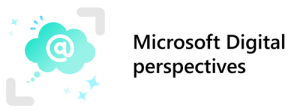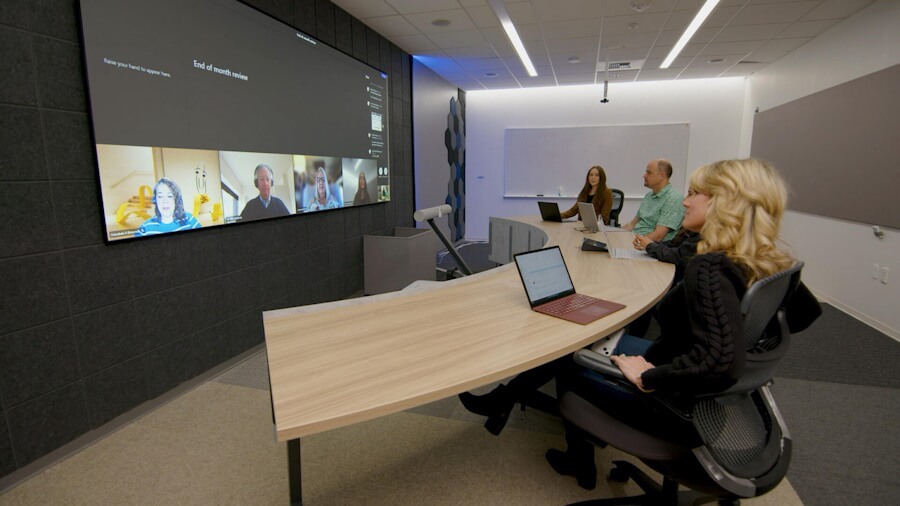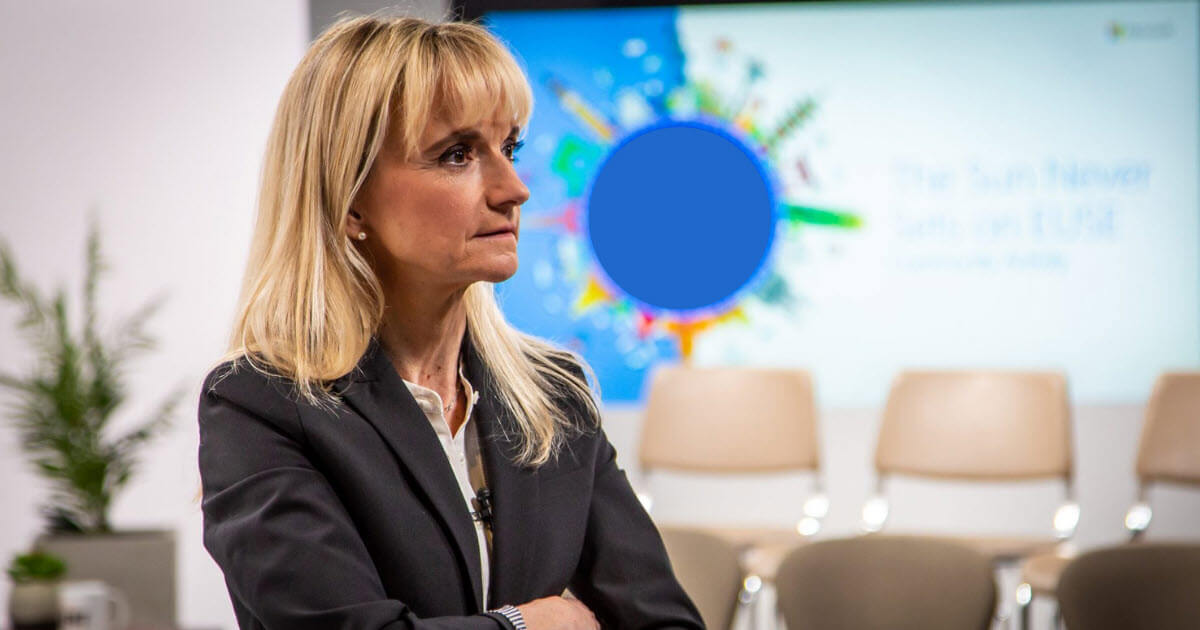 One of the most challenging aspects of leading the Employee Experience team at Microsoft is the deployment, maintenance, and support of thousands of conference rooms around the globe. Since employees often encounter different conference room technology—even within the same building—it can lead to frustration, delay, and even support calls. As a result, employees have consistently identified that experience as an area for improvement.
One of the most challenging aspects of leading the Employee Experience team at Microsoft is the deployment, maintenance, and support of thousands of conference rooms around the globe. Since employees often encounter different conference room technology—even within the same building—it can lead to frustration, delay, and even support calls. As a result, employees have consistently identified that experience as an area for improvement.
By investing in the meeting experience with Microsoft Teams and by reimagining the physical and virtual spaces where meetings take place, we’re laying a foundation of innovation that will help Microsoft employees and our customers thrive in a hybrid world of work.
—Nathalie D’Hers, Corporate Vice President, Employee Experiences
Thanks to Microsoft Teams and the innovation being driven by the product team, we’ve seen a real opportunity to transform Microsoft employee and customer meetings from a weakness to a strength. By investing in the meeting experience with Microsoft Teams and by reimagining the physical and virtual spaces where meetings take place, we’re laying a foundation of innovation that will help Microsoft employees and our customers thrive in a hybrid world of work.
We’ve already seen satisfaction with meetings increase, while also making sure hybrid work remains seamless for Microsoft and our customers. How are we doing it? I’m glad you asked!
Simple questions, complex answers
The Microsoft’s WorkLab blog describes hybrid work as …”a blended model where some employees return to the workplace and others continue to work from home.” The Microsoft 2022 Work Trend Index identified five key trends driving hybrid work. While all are relevant, two stood out to us:
- Employees have a new “worth it” equation
- Leaders need to make the office worth the commute
It was clear we had some work to do as a team to ensure a successful hybrid future. My team asked two simple questions:
- What is the value of our physical work environment in a hybrid work world?
- What kind of meeting experiences satisfy the modern world of hybrid work?
Our answer to the first question was simple—to socialize and to collaborate. The pandemic tested all of us in innumerable ways, but a common response from employees, even those who have enjoyed the flexibility to work from home, is how hard it can be to collaborate remotely. The ability to socialize and connect is closely related, as both of those activities build trust, an essential ingredient of successful teams. We determined that the meeting experience of the future needed to honor the value of physical space while making it possible for everyone to fully participate, regardless of where they were.
The second question was more complicated. We recognized the need for simple, powerful meeting experiences in our facilities and had been working on just that in the years leading up to the pandemic. But how could we reimagine the meeting experience to enable our employees to collaborate without friction and feel connected even if physically apart? Microsoft Teams has already implemented an innovative feature in Together Mode to help make hybrid teams more connected. But how could we take that vision to the next level?
The way things were—hybrid meetings in an in-person world
To answer that question, contributors across Microsoft have built prototypes in a space we call “the Hive,” a design environment optimized for reimagining physical and virtual spaces. In the Hive, PMs, designers, and software engineers are empowered to question everything, so no idea goes unexplored, and no constraints go unchallenged. This approach led to breakthroughs across both physical and virtual space.
In the physical world, a typical Microsoft conference room consists of a rectangular table, with space for six to 18 people, dependent on room size. It’s a pretty traditional layout you’ve likely seen before. A large monitor or projector screen is mounted on a wall. In person attendees are oriented toward each other on either side of the table, not facing the screen unless they tilt their chairs. Online participants are out of sight during discussion, only visible when in-person participants are focused on the screen. Physical white boards are situated on either side of the table, out of view for online participants. These traditional conference rooms were designed and optimized for in-person collaboration, inadvertently putting remote participants at a disadvantage.
In the virtual space, Teams focuses on a shared presentation or a “spotlighted” presenter. Whomever shares their screen needs to choose what additional details to display whether it be the list of attendees, the chat window, or neither, in order to maximize presentation space. While Teams is highly optimized for the online meeting experience, the hybrid meeting experience was uneven. We realized quickly we had some work to do if hybrid meetings were going to continue to be the future of work at Microsoft and for many of our customers.
Building the perfect meeting
To address these shortcomings, we spun up a virtual team comprised of product engineers, representatives from our facilities team, and the Microsoft Digital team. Together, we imagined a new meeting room experience that would offer a corporate boardroom-like experience for all employees.
The team began by shifting the center of the room from the middle of a table to the halfway point between in-person and remote attendees. They imagined a “single pane” of content instead of multiple screens, where remote attendees could appear at eye level and approximately life size. With the seating arrangement allowing more viewable space, content takes center stage, with still more room for chat and other meeting content at the sides.
As the team iterated, they began to see an exciting new experience taking shape: one that brought people together across physical and virtual spaces. Remote attendees might join from their phone, their home, or a focus room somewhere else on campus, but each participant was on equal footing and on the same page.

As the heartbeat of the employee experience across the company, and as part of the team that propels the company forward in terms of modern workplace patterns and practices, it’s important that we provide an inspirational enterprise blueprint for customers and partners.
—Nathalie D’Hers, Corporate Vice President, Employee Experiences
Since sharing these prototype designs, the response has been overwhelmingly enthusiastic. Unlike bespoke systems from some of our competitors, the new meeting room experience we’ve envisioned can be created and supported with commodity hardware at modest cost and powered via enhancements to our already ubiquitous Microsoft Teams product. We were thrilled when Microsoft Corporate Vice President Jared Spataro and Microsoft CEO Satya Nadella highlighted this prototype environment in their talks at Microsoft Ignite, and since then there has been an outpouring of interest from customers and hundreds of engagements at The Hive.
From “traditional IT” to “stewards of the Employee Experience”
This new meeting experience is a great example of how my team inspires our Microsoft product teams by thinking holistically about the employee experience and driving innovation that helps our customers. As the heartbeat of the employee experience across the company, and part of the team that propels the company forward in terms of modern workplace patterns and practices, it’s important that we provide an inspirational enterprise blueprint for customers and partners.
With this new meeting room experience, we’re leading the way and preparing for a future of hybrid work that is here to stay, and where everyone regardless of their physical location can collaborate, socialize, and feel like a trusted and important member of the team. To support that vision, we’ve published a free guide for business leaders to help navigate the complexities of the hybrid workplace. Coupled with inclusive meeting behaviors, we believe that hybrid meetings can be just as productive as in-person meetings if done right.
It’s been exciting working with our counterparts in product development and facilities to turn this prototype into a real experience that will help everyone to be more productive. It’s a great demonstration towards our commitment to Microsoft’s mission to Empower every person and every organization on the planet to achieve more.

- Familiarize yourself with Microsoft Teams Meeting Guide to enhance video conferencing, chat, document collaboration, and integration functionalities.
- Evaluate your current meeting spaces, whether physical or virtual, and identify areas where improvements can be made. Consider how you can create a more inclusive and engaging meeting environment that promotes collaboration and participation for both remote and in-person attendees.
- Embrace the concept of hybrid work within your organization. Encourage employees to adapt to the hybrid work model and establish inclusive meeting practices that ensure everyone, regardless of their physical location, feels connected and valued during meetings.






